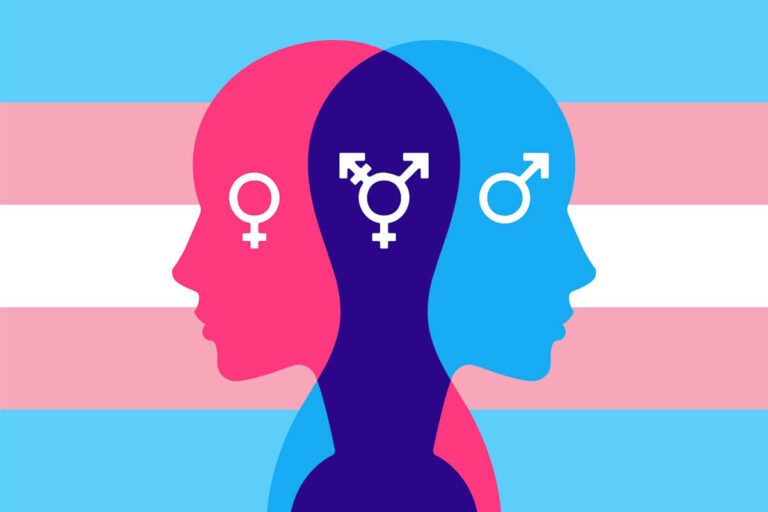Coming out as someone who identifies with a gender different from the one assigned at birth can be a life-changing experience. For those who identify as transgender, the journey of telling people about their true selves is unique and deeply personal. Coming out can be different for everyone, as it's often shaped by individual experiences, living situations, and support networks. In this article, we'll explore the top tips to help you navigate this important part of your journey.
When you're ready to share your story, it's essential to remember that there is no one-size-fits-all approach. For some, coming out might mean openly discussing their identity as male or female, while for others, it might come in more subtle ways. You may feel a strong sense of self and be eager to tell everyone, or you might not feel quite ready to share your truth with the world. It's essential to recognize that you don’t have to come out if you don’t need or want to. This is a personal decision, and what feels right for one person may not be the same for another. The key is to make informed decisions based on your unique circumstances and feelings, ensuring that you feel safe and supported throughout the process.
Navigating the Emotional Landscape: Building Trust and Understanding on Your Coming Out Journey
When considering who to tell, it's natural to experience a mix of emotions, from excitement to fear. Coming out can be an emotional rollercoaster, filled with moments of joy, confusion, and even heartache. It's essential to surround yourself with people you trust and who can offer support during this time. Keep in mind that reactions may vary, and not everyone will understand right away. Some people may have questions or may want more information, while others may struggle with preconceived notions and stereotypes about what it means to be someone who identifies with a gender different from their assigned one. In these cases, patience and education can help break down barriers and create a more supportive environment.
Embracing Change and Growth: A Guide to Your Authentic Coming Out Journey
As you embark on this journey, it's important to remember that it's okay to make mistakes and evolve along the way. Your understanding of your own identity, as well as your expression of masculine or feminine traits, may change over time. Don't be afraid to seek guidance from others who have been through similar experiences, as their insights can help you make the best decisions for yourself. Keep in mind that coming out is not a one-time event, but rather a process that unfolds over time. Embrace the journey with open arms and an open heart, and always remember that your identity is an important part of who you are, regardless of how you choose to share it with the world.
As we delve into the top tips for coming out as your authentic self, remember that your journey is unique, and the steps you take should reflect your personal experiences and needs. In the following sections, we'll provide guidance and advice to help you through this transformative period. Whether you're seeking information on understanding your identity, building a support network, or navigating challenging situations, our aim is to offer insights that empower you to make the best decisions for your life. Let's explore these essential tips together and celebrate the beautiful journey toward embracing your true self.

Understanding the Transgender and Nonbinary Identity
If you're trying to learn more about transgender and nonbinary identity, you're in the right place - let's dive in! Understanding transgender and nonbinary identity is a journey that can be both challenging and rewarding. Transgender and nonbinary individuals have an identity that is different from the gender they were assigned at birth and the gender that society typically expects them to have. This gender identity is not based on sexual orientation, although it is often confused with it. Transgender and nonbinary individuals may have a gender identity that is neither male nor female or a combination of both.
There are many different gender identities that are considered transgender or nonbinary. These include agender, genderqueer, genderfluid, demi gender, and many more. Each gender identity is unique, and individuals should not feel pressure to fit into any one box. It is also important to remember that gender identity is not related to sexual orientation and that there are many different sexual orientations within the community.
Coming out can be a complicated and emotional process. It is important to take the time to find information and resources to help make the journey easier. It is also important to create a supportive environment for yourself and to find people who will accept and celebrate your identity. By taking the time to learn about identities, you will be better prepared to make the best decisions for yourself and your journey. With the right resources, you will be well on your way to living a life that is true to your identity.
Finding Information and Resources for Your Journey
With a wealth of information and resources available, your journey toward self-discovery doesn't have to be a solo one. Whether you are just beginning to explore your identity or are looking for someone to talk to, there are plenty of options to choose from. It is important to start by connecting with trans people who have experienced the same challenges. A great way to do this is by joining a support group. Through these groups, you can talk to other people in a safe, non-judgmental environment, and make valuable connections. A therapist can also be a good source of support.
A qualified therapist can provide you with information, resources, and an understanding ear. Additionally, they can help you work through any difficult emotions you may be facing as you explore this new part of yourself. Finding the right therapist is essential, so do your research and take the time to find someone you feel comfortable with. With the right support, you can take the next steps toward embracing your identity.
Preparing to Come Out as Transgender
Coming out as transgender can be an empowering journey, but it's important to be prepared before taking the first step. Having a support system in place is essential, as well as understanding the terminology around gender identity and sexual orientation. It is important to note that being transgender is not the same as being lesbian, gay, or bisexual (LGB) and that one's gender identity is not related to their sexual orientation.
It is also important to understand the different levels of coming out and the risks associated with it. Coming out is a gradual process, and there is no right or wrong way to do it. It is a personal decision, and one should assess the possibilities before making the decision to come out. And it is important to be aware of the potential risks of coming out such as discrimination, rejection, or violence from those who might not understand.
It is important to remember that being trans is not something to be ashamed of. Educating oneself on gender identity and understanding one's own identity is essential for a successful coming out. It is also essential to have a support system in place, whether it is family, friends, or a professional, and to feel comfortable in one's own skin before taking the first step.
How to Come Out as Trans to Friends and Family
Taking that first step to come out as trans can feel like a brave leap into the unknown, but with a supportive network of friends and family, the journey can be eased. Deciding to come out as trans is a personal decision and should be taken seriously. It is important to know that there is no right or wrong way to come out, but some factors to consider are:
- Establishing a support system beforehand: having a supportive group of friends and family who will be there for you throughout the process is invaluable.
- Deciding who to tell: the person or people you are most comfortable with is a great place to start. It is also important to remember that while some people may be unsupportive, it is not a reflection of you.
- Being educated: learning as much as possible before coming out is important. It could be helpful to talk to someone who has been through the process before, read articles and books, or attend support groups.
The journey of coming out as trans can be difficult, but also exhilarating and liberating. It is important to remember that you are not alone and that there are many people who are here to support you. With the right preparation and a positive attitude, coming out can be a positive experience.

Handling Rejection and Unsupportive Responses
After coming out as trans, it's important to be prepared for unsupportive and even rejecting responses, but with the right support system, it's possible to cope. It can be difficult to face discrimination or rejection for something you have no control over, such as the gender you were assigned at birth. However, it can also be liberating to know that you can be your true self without fear or shame. It is important to remember that no matter what comes your way, you are not alone and that there are resources available to help you.
It is important to be aware that coming out as trans can lead to discrimination and violence, especially if the people you come out to are not accepting and understanding. There are laws in place to protect you from discrimination and harassment, but it is still important to take steps to protect yourself. This can include having a support system of friends and family who are accepting and understanding and seeking out organizations that provide support and resources for transgender individuals.
The most important thing to remember when handling unsupportive or even hostile responses is that it is not your fault. You have the right to be your true self and no one should make you feel ashamed or guilty for doing so. It is also important to remember that although there may be people who are not supportive, there are people who will be understanding and accepting. Seek out those people and create a supportive environment for your transition.
Creating a Supportive Environment for Your Transition
Creating a supportive environment for your transition is essential for a successful and healthy journey, so don't hesitate to reach out to those who can provide you with understanding and acceptance. It is important to express your true gender identity to those around you who will accept and support you. This can be done through conversations, social media posts, or even hormone therapy. It is also important to identify as a trans woman in all aspects of your life, such as work, school, and relationships. To create a supportive environment for your transition, here are some steps you can take:
- Find a therapist or counselor who is knowledgeable about transgender issues and is supportive of your transition.
- Join a support group with other transgender or nonbinary individuals.
- Connect with other transgender people in your community.
- Seek out resources such as books, blogs, and websites about transitioning.
- Educate yourself about the transgender community.
By creating a supportive environment, you can have the right people around you to help you on your journey. It is important to remember that your transition is a personal process and you should not be pressured to come out as transgender if you are not ready. Everyone's journey is different, but it is important to stay positive and surround yourself with those who can understand and accept you for who you are. With the right people beside you, you can move forward with confidence and continue your journey with love and support.
| Pro Tip: |
|---|
| While embarking on the exciting journey of dating, safety should always be a priority. Discover essential Trans Dating Safety Tips to help you navigate the world of romance with confidence and care. |

The Right Way to Come Out as Transgender: Do’s and Don’ts
Coming out as transgender can be an empowering and liberating experience, but it's important to make sure you do it the right way. It's important to remember that everyone's journey is unique and there is no single way to come out. When coming, it's important to remember to be patient with yourself and to use the pronouns and names you feel most comfortable with. It's also important to set up a support system before coming out and to have resources on hand to help others understand and support you on your journey.
Before coming out, make sure to research the potential consequences of coming out in your situation and to make sure you are in a safe and supportive environment. It's also important to be aware of the potential discrimination and violence that can be experienced. It's also important to consider your own comfort level when deciding who to come out to and when.
When coming out, it's important to be conscious of how you present your gender identity to others. It's also important to keep in mind that it may take time for people to accept your gender identity and that it's okay if they don't. Remember to be kind to yourself and to those around you, and to seek out the support you need. Coming out can be a difficult and emotional process, but doing it the right way can be an empowering and liberating experience.
| Pro Tip: |
|---|
| As you express your true self, makeup can be a powerful tool for self-expression. Check out the Top 13 Makeup Products for Trans Women to enhance your beauty and boost your confidence. |
Helping Others Understand and Support Your Journey
It's essential to have resources on-hand to help those around you understand and support your journey, so they can join you as you take this brave leap into the unknown. When coming out to family, friends, and co-workers, it can be helpful to provide them with resources to understand your journey. LGBT organizations like Lambda Legal and GLAAD provide resources to help people better understand the LGBTQ+ community. For family members, it may be helpful to provide them with books written by transgender authors, such as Janet Mock’s Redefining Realness, or the novel Becoming Nicole by Amy Ellis Nutt.
Articles, podcasts, and websites can also be helpful in understanding the transgender experience. Websites like MyTransgenderCupid provide information on trans dating, while podcasts like TransPanTastic offer stories and experiences from the transgender community. For those who need more in-depth information, the Transforming Family program provides comprehensive education on the transgender experience.
It can also be beneficial to provide those you come out to with contact information for support groups, such as Q Chat Space and Glaad. These sites provide a safe space to connect and share their experiences. Having access to support groups can be invaluable in providing comfort and understanding during the coming out process. By having resources available to those around you, you can help them understand and support your journey.
| Pro Tip: |
|---|
| Feeling comfortable and confident in your own skin is important. Explore valuable advice on Passing as a Trans Woman to help you present yourself authentically and with self-assurance. |
Navigating the Workplace as a Transgender or Nonbinary Person
Navigating the workplace as a transgender or nonbinary person can be intimidating, but with the right resources and support, it's possible to find success and acceptance. Here are a few things to consider when taking on such a journey:
- Educate yourself on the laws in your state to ensure you understand your rights and how to protect them. It is important to know that discriminating against someone for their gender identity is illegal in several states, and it is important to speak up if you experience this in your workplace.
- Before coming out at work, it is important to assess the potential consequences and to reach out to LGBTQIA+ resources for advice. It can be helpful to build a support system in the workplace with colleagues who understand and respect your gender identity before coming out.
- There are many ways to come out, such as talking directly with a supervisor or coworkers, writing an email or letter, or even creating a presentation. Whatever the method, it is important to have a plan and to consider the potential reactions of those around you.
By understanding the legal rights and protections available to you, having a plan and a supportive network, and finding resources to help, you can make the process of coming out in the workplace less intimidating. Accessing healthcare and transition-related services can help make the transition much smoother.
| Pro Tip: |
|---|
| Love knows no boundaries, and dating can be an exciting adventure. Get insightful tips on Dating as a Trans Woman to help you find meaningful connections and lasting relationships. |
Accessing Healthcare and Transition-Related Services
Healthcare and transition-related access services can make the transition smoother, so it's worth looking into what's available. One of the most important questions to consider is whether or not the provider is trans-friendly. It is also important to look into whether or not the provider will honor the means to be trans, as well as the coming out process.
In order to make sure transgender and nonbinary people receive the healthcare they need without discrimination, it is important to ask for referrals from friends, family, and support groups. There are also many online resources that can help find trans-friendly healthcare providers.
| Table 1 | ||
|---|---|---|
| Name | Description | Link |
| Planned Parenthood | Offers reproductive healthcare and information | www.plannedparenthood.org |
| Q Chat Space | Support for LGBTQ+ teens | www.qchatspace.org |
| Glaad | Support for LGBTQ+ | www.glaad.org |
Accessing healthcare and transition-related services is key for a smoother transition. It is important to make sure the provider is trans-friendly and will honor the means to be trans, as well as the coming out process. There are online resources available to help find trans-friendly healthcare providers and support groups to ensure transgender and nonbinary people receive the healthcare they need without discrimination. With the correct resources and support, transgender and nonbinary individuals can feel empowered in their transition.
| Pro Tip: |
|---|
| Taking care of your skin is an essential aspect of self-care. Learn about Skincare Tips for Trans Women to help you maintain a radiant complexion and feel your best, inside and out. |

When You Want to Tell the World: Coming Out as Trans on Social Media
Sharing one's gender identity on social media can be a liberating experience, allowing trans and nonbinary individuals to take control of their story and share it with the world. Social media offers a platform for trans and nonbinary individuals to share their experiences and stories, and to connect with a larger community of like-minded people. This can be particularly beneficial for those who choose to come out to a larger group of people. Telling one person at a time can be intimidating and overwhelming, but sharing with a larger group can be less daunting and can allow individuals to find the support they need. Additionally, social media offers a platform to connect with other lesbian, gay, bisexual, trans men, and queer (LGBTQ+) individuals who are also navigating their identity and coming out process.
Coming out on social media can also be an empowering experience. It can provide individuals with a sense of control over how and when they come out and to whom. Social Media can also provide an opportunity to show the world who they really are, rather than allowing the world to make assumptions about their identity. It can be a way to express their true self without having to explain or justify their identity.
By coming out on social media, trans and nonbinary individuals can take control of their stories, find support from their community, and express their true selves without having to explain or justify their identities. By embracing their true self, individuals can help others along the way by being visible and positive examples of LGBTQ individuals in the world. Through this, individuals can help educate others about the unique beauty of trans and nonbinary individuals and the importance of acceptance and inclusion.
Conclusion: Embracing Your True Self and Helping Others Along the Way
By coming out as trans or nonbinary, you can take control of your story, find support from your community, and express your true self without having to explain or justify your identity. Coming out is a personal decision that should be taken with care, and it is important to figure out who you want to tell and when. Here are three steps to help you come out:
- Educate yourself: Learn more about terminology, gender identity, and the history of trans and nonbinary people. This will help you have informed conversations and better come to terms with your identity.
- Find support: Create a support system of friends and family that you can rely on. Having those you trust can be essential when facing potential discrimination or backlash.
- Be intentional: Figure out which aspects of your identity you would like to share and how. Coming out can be done gradually, but it is important, to be honest with yourself and those around you.
Ultimately, coming out as trans or nonbinary is an important step in embracing your true self and living authentically. It is important to remember that cisgender people also play a role in creating an inclusive and accepting environment by being open and understanding. Though it can be daunting and scary, coming out is ultimately a liberating experience and can lead to more meaningful connections with the world around you.




